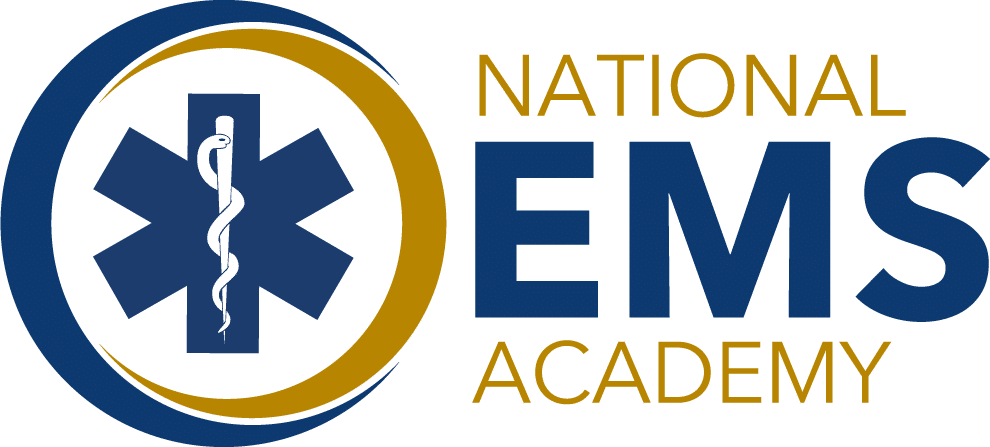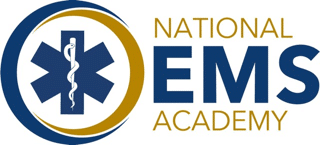FAQs
How does a hybrid EMT class work?
A hybrid EMT class combines the flexibility of online learning with the essential, hands-on training needed to learn how to save lives.
Online Learning: Students complete much of the instructional and conceptual material online—covering topics such as anatomy and physiology, patient assessment theory, EMS systems, and medical ethics—on their own schedule online. This makes the program accessible to working adults, parents, students, and anyone looking for a more flexible training pathway.
In-Person Training: Certain lifesaving skills must be practiced in person. The following are examples of what can only be mastered through hands-on practice with instructors and peers:
- CPR
- airway management
- bleeding control
- patient lifting and moving
- trauma response
Hybrid programs also include ride-alongs with EMS crews, giving students the chance to apply classroom knowledge in real-world settings.
After Hybrid EMT Classes: Graduates of a hybrid EMT program are well-prepared to begin their careers in emergency medicine. Completion of the program and successful certification open the door to opportunities with fire departments, private ambulance services, hospitals, and medical teams. For many, EMT training also serves as a first step toward advancing into roles such as paramedic, nurse, or physician assistant.
How Long Are Hybrid Classes?
The duration of a hybrid EMT class varies depending on the program design. Some accelerated courses can be completed in as little as 8 weeks, while others may take 4–6 months to allow for greater flexibility.
Regardless of the pace, all our programs are designed to meet state and National Registry of Emergency Medical Technicians (NREMT) requirements. Students complete final in-person skills testing and a computer-based NREMT exam to earn certification.
To succeed in a hybrid class, students should expect to dedicate 10–20 hours per week to study, practice, and engage in in-person classes.
Is a hybrid EMT class the same as a self-paced/independent study class?
No, a hybrid EMT class is not self-paced or an independent study. While the format does offer flexibility through online learning, it still follows a structured schedule with clear deadlines. Students must adhere to a defined schedule that includes:
- Weekly deadlines for assignments and quizzes
- Mandatory participation in online discussions and group activities
- Scheduled in-person sessions for hands-on training and skills assessments
- Instructor-led modules that follow a fixed timeline
Hybrid EMT courses combine the convenience of remote learning with the rigor of traditional classroom instruction. Unlike self-paced or independent study formats, students cannot progress entirely at their own speed. Attendance, engagement and timely completion of coursework are required to remain in good standing.
All expectations for hybrid EMT training will be outlined in the course syllabus.
Is taking a hybrid EMT class easier than a traditional In-Person class?
While hybrid EMT classes offer more flexibility, they are not inherently easier than traditional face-to-face programs. The course content, learning objectives and certification requirements are typically identical across both formats, however.
Students in hybrid programs must master the same material and demonstrate the same competencies as those in conventional classroom settings. The difference lies in how the material is delivered, and that can present challenges that might not be present in a traditional classroom setting.
Hybrid students require a high level of self-discipline, time management and technical proficiency. Students must be comfortable navigating online platforms, watching instructional videos, completing assignments and staying on track without daily in-person reminders. For some, this format feels more demanding than a traditional class.
To succeed, students should:
- Have strong reading comprehension and critical thinking skills
- Be comfortable using a computer or tablet for online coursework
- Maintain access to high-speed internet for streaming lectures and taking exams
- Be proactive in communicating with instructors and peers
- Stay organized and meet weekly deadlines without direct supervision
Hybrid EMT classes are a great fit for motivational learners who value flexibility, but they require just as much effort as traditional programs.
What technology, software and skills do I need to succeed in an EMT hybrid course?
To be successful in a hybrid learning environment, students need both the right equipment and a foundational set of digital skills.
Students should have access to a laptop or desktop computer with a reliable high-speed connection to the internet. This ensures smooth access to course materials, video conferencing and online discussions. Mobile devices can be useful for quick access, but they are not sufficient for completing assignments or participating in virtual class sessions.
All hybrid and online courses use Canvas as the Learning Management System (LMS), which is best supported by the latest versions of Firefox or Chrome. Instructors may also require course-specific software, such as Microsoft Office or Zoom. Students should check their course syllabus or announcements for any additional software requirements.
In addition to hardware and software, students should be comfortable using common internet tools and online platforms. This includes basic proficiency with web browsers, email programs and Microsoft Office. Knowing how to attach and open documents, organize bookmarks and participate in online discussions is crucial. Students should also be able to perform effective internet searches using multiple search engines and feel confident in troubleshooting minor technical issues.
Do I need to own a computer to enroll in Hybrid EMT classes?
Yes, all students enrolled in hybrid courses are required to have access to a personal computer that meets specific technical standards. This is not just a recommendation’ it’s a requirement for participation in coursework, virtual meetings and online exams. The computer must be capable of running necessary software and include a functional webcam and microphone, as these are often used for class activities, identity verification and proctored assessments.
Importantly, certain devices are not permitted for use during exams. These include Chromebooks, Surface Pros, Kindles, smartphones, tablets and iPads. While these devices may be useful for reading materials or checking announcements, they do not meet the technical requirements for secure testing environments and may not support all course software.
Students who do not currently own a qualifying computer should plan to acquire one before the start of the term.
How much time will I spend in a Hybrid EMT class, and do I need to log in at specific times?
Hybrid courses require a time commitment comparable to traditional face-to-face classes. You should expect to spend the same number of hours per week as you would on in-person courses. This includes time for lectures, assignments, readings, discussions and exams.
In most cases, hybrid classes do not require you to log in at a specific time. Instead, you’ll have weekly deadlines for submitting assignments, completing quizzes and participating in online discussions. This asynchronous format allows you to work at your own pace within each week, but it also means you’ll need to be proactive and stay focused on deadlines.
If you encounter challenges or have questions, you’re encouraged to contact your instructor directly or use the course discussion board to seek help from classmates. Staying engaged and asking for support when needed are key strategies for success in a hybrid learning environment.
What are some tips for managing time in a Hybrid EMT course?
- Treat the course like an in-person class in terms of weekly time commitment
- Create a consistent schedule for studying and completing assignments
- Check Canvas regularly for updates, deadlines, and feedback
- Reach out to your instructor or peers if you need help
- Avoid waiting until the end of the week to start your work
How do I submit homework and take quizzes or exams online?
Canvas is the learning management system (LMS) used by many schools and colleges to organize coursework, assignments, quizzes and grades. If you’re enrolled in a course that uses Canvas, here’s how you’ll complete and submit your work.
Submitting homework and assignments
To turn in homework:
- Log in to your Canvas account and navigate to your course dashboard.
- Click on the “Assignments” tab or locate the assignment within a Module.
- Select the assignment you want to submit.
- Click the “Submit Assignment” button.
- Choose the appropriate submission type (e.g., file upload, text entry, external tool).
- Upload your work and click “Submit” to finalize.
After submission, Canvas will display a confirmation message and timestamp. You can also check the Grades section to verify that your assignment was received.
Taking quizzes and exams
To take a quiz or test:
- Go to the “Quizzes” section of your course or find the quiz in a Module.
- Click on the quiz title to view instructions and time limits.
- Click “Take the Quiz” to begin.
- Complete all questions and click “Submit Quiz” when finished.
Depending on your instructor’s settings, you may see your score immediately or after manual grading.
What can I expect from my instructor in a hybrid EMT class?
In a hybrid or online course, your instructor will provide the same level of academic support and structure as in a traditional classroom setting. You can expect:
- A detailed syllabus and course schedule outlining expectations, deadlines and grading policies.
- Assignments with clear instructions, along with timely and constructive feedback.
- Prompt responses to questions, typically within 24–48 hours during the workweek.
- Transparent grading timelines for homework, quizzes and exams.
- Enforcement of netiquette and online communication protocols to ensure a respectful learning environment.
However, it’s important to understand the boundaries of virtual instruction. You should not expect 24/7 availability. Instructors typically observe virtual office hours and may not respond to messages during evenings or weekends.
What do Hybrid instructors expect from students?
Instructors in hybrid and online courses expect students to engage with professionalism, responsibility and respect. Expectations include:
- Active participation in online discussions, group work and in-person sessions.
- Professional communication in emails, forums and collaborative platforms.
- Adherence to academic integrity, including proper citation and original work.
Students should avoid the following behaviors:
- Plagiarism: Using someone else’s words or ideas without proper acknowledgment.
- Submitting recycled work: Reusing assignments from other classes without permission.
- Misrepresentation: Submitting work that was written or revised by another person.
- Inappropriate online behavior: This includes cyberbullying, offensive remarks or disruptive conduct.
- Unauthorized use of AI tools like ChatGPT to complete assignments, quizzes or tests.
All expectations will be outlined in the course syllabus. Maintaining respectful communication and academic honesty is essential to staying in good standing and succeeding in a hybrid learning environment.
What are the best tips for succeeding in a hybrid EMT class?
Hybrid courses offer flexibility by combining online learning with in-person instruction, but they also require strong time management and self-discipline. Here are key strategies to help you stay on track and succeed:
- Treat hybrid classes like traditional classes
- Stay ahead of deadlines
- Have a backup plan for tech issues
- Communicate proactively
- Collaborate with peers
- Practice professionalism and academic integrity
- Work with a small group, either in person or via email
How do I get started with a hybrid EMT course?
To begin your journey as a hybrid or online student, the first step is to start the registration process.
- Go to the National EMS Academy website
- Select Become a Medic
- Register for your state (Texas. Louisiana or Tennessee)
- Click Apply Now and start your journey as an EMT
How much does the Texas EMT program cost?
Tuition for the Texas EMT course offered through the National EMS Academy is subsidized to $600, but this base cost does not include all expenses.
Additional fees may apply for course materials, uniforms, certification exams and other required supplies. These extra costs can vary depending on the specific class location and program structure.
How long does it take to get certified through the Texas EMT program?
The Texas EMT program can be completed in as few as 12 weeks. This entry-level training equips students with the skills needed to provide basic emergency care and prepares them for the National Registry EMT certification exam.
The National Registry EMT certification exam is a standardized test administered by the National Registry of Emergency Medical Technicians (NREMT). It’s designed to assess whether candidates have the entry-level knowledge and skills required to perform as Emergency Medical Technicians (EMTs).
How much do EMTs and paramedics get paid in Texas?
Average EMT Compensation
- Starting Salary: $36,000–$47,000 per year
- Mid-Career Salary: Varies by employer and region. Actual pay will likely depend on your location, employer and work schedule.
Average Paramedic Compensation
- Starting Salary: $51,000–$64,000 per year
- Mid-Career Salary: May increase with experience and specialized roles. Actual compensation depends on factors like geographic area, years of experience and job responsibilities.
How often are classes offered in Texas?
EMT Classes begin approximately every two months, providing frequent opportunities for new students to enroll and begin their training.
The paramedic program launches twice a year, with classes starting in the Spring and Fall semesters. This schedule allows students to plan ahead and complete any prerequisites, such as EMT certification.
For the most accurate and up-to-date class start dates, please contact the program directly or visit the official website. Availability may vary by location and enrollment demand.
Will I get a job after I complete the Texas program?
After completing the Academy’s EMS program, students must pass the National Registry of Emergency Medical Technicians (NREMT) exam to earn official certification.
Once certified, EMTs and paramedics are eligible to apply for positions in any state they wish to work in.
EMS professionals are in high demand nationwide, with growing opportunities across both public and private sectors.
Acadian Ambulance is actively hiring EMTs and paramedics throughout its service areas in Texas, offering career paths for both entry-level and experienced personnel.
Do I have to own a computer to enroll in the Tennessee EMT Program?
To enroll in the Tennessee Program, you must own a computer that meets specific technical requirements. This is not optional. All students are required to have access to a personal computer that will be used for coursework, virtual class participation and secure online exams.
Here are the key requirements:
- Device Type: You must have a standard laptop or desktop computer. The program does not allow the use of Chromebooks, Surface Pros, Kindles, smartphones, tablets or iPads, especially during exams.
- Webcam Requirement: Your computer must be equipped with a functional webcam, which is essential for identity verification and monitoring during online assessments.
- Exam Compatibility: The computer must be compatible with the exam software used by the program. This software typically requires a full operating system (Windows or MAC) and may not run properly on mobile or hybrid devices.
If you do not currently own a suitable computer, you will need to acquire one before starting the program. This ensures you can fully participate in all academic activities and meet the technical standards required for secure testing environments.
When will I find out if I’ve been accepted into the Tennessee EMT program?
After you complete the required Pre-course Assessment, the Tennessee EMT Program will notify you of your acceptance status. You can expect to receive this notification approximately one week before orientation begins.
This timeline allows the program to review your assessment results and finalize enrollment decisions. If you haven’t received any communication by that time, it’s recommended to check your email (including spam or junk folders) or contact the program directly for an update.
How long is a skills day class in the Tennessee EMT Program?
In the Tennessee EMT Program, skills days are held twice a week, rotating between Monday/Tuesday and Wednesday/Thursday. Each skills day lasts for a full 8 hours.
These sessions are designed to give students hands-on training in essential emergency medical procedures and patient care techniques. The extended duration ensures that students have ample time to practice, receive feedback and build confidence in their skills under instructor supervision.
If you’re planning your schedule, be sure to set aside full-day availability on your assigned skills days.
What is the duration of the Tennessee EMT Program?
The Tennessee EMT Program runs for a total of 15 weeks. This training period is divided into two structured sections:
- EMT I – The first phase of the program, covering foundational knowledge and basic emergency medical skills.
- EMT II – The second phase, which builds on EMT I and includes more advanced clinical skills, scenario-based training and exam preparation.
Throughout the 15 weeks, students participate in classroom instruction, hands-on skills days and assessments designed to prepare them for certification and real-world emergency response.
Can I get financial aid for the Tennessee EMT Program?
The Tennessee EMT and Paramedic programs are no longer eligible for federal financial aid through FAFSA. However, there are still alternative funding options available to help cover the cost of training:
- Workforce Development Aid
Students are encouraged to contact their local Business and Career Solutions Center. These centers often have workforce development funds set aside for individuals pursuing high-demand careers like emergency medical services. Aid availability may vary by county, so it’s important to reach out to the center serving your area.
- EMT Apprenticeship Opportunities
You may be able to onboard as an EMT apprentice, which can provide financial support or paid training while you complete the program. Apprenticeships often combine classroom instruction with on-the-job experience
- EMR Pathway
If you are already a licensed Emergency Medical Responder (EMR), you may qualify for advanced placement or financial support through certain training pathways. This can reduce costs and shorten the time needed to complete EMT certification.
Will I get a job after completing the Tennessee EMT Program?
Completing the Tennessee EMT Program is a major step toward starting a career in emergency medical services, but it’s important to understand the full process and job outlook:
Certification Requirement
After finishing the program, you must pass the National Registry of Emergency Medical Technicians (NREMT) exam to earn your official EMT certification. This certification is required to work as an EMT or paramedic in most states.
Job Opportunities
Once certified, you can apply for EMT positions in any state where you meet licensing requirements. The demand for EMS professionals is high nationwide, especially in both urban and rural areas.











